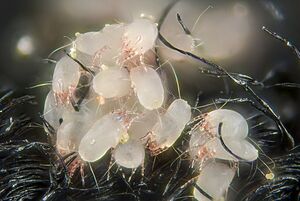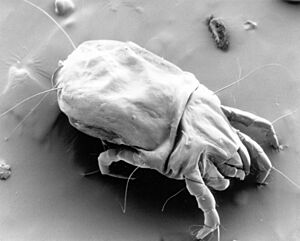House dust mite facts for kids
House dust mites are tiny creatures that live in the dust in our homes. They are a type of mite, which means they are related to spiders. You can't see them without a microscope because they are so small.
Dust mites are well-known because they can cause allergies in many people.
Contents
What Are House Dust Mites?
House dust mites belong to a family of mites called Pyroglyphidae. They live in homes all over the world, which is why they are called "cosmopolitan."
What Do They Look Like?
Because they are so small and their bodies are almost clear, you can't see dust mites with just your eyes. A typical dust mite is only about 0.2 to 0.3 millimeters long. That's smaller than a grain of sand!
Their bodies have a striped, shell-like covering called a cuticle. The tiny waste particles, or droppings, they leave behind are also very small, about 10 to 40 micrometers.
Where Do They Live?
Dust mites can be found in homes worldwide, but they especially like places that are warm and humid. They are often found in:
- Beds and pillows
- Carpets
- Upholstered furniture (like sofas and chairs)
- Stuffed animals
Studies have shown that most homes in the United States and Europe have dust mites.
Different Types of Dust Mites
There are many different species of dust mites. Some of the most common ones include:
- Dermatophagoides farinae (the American house dust mite)
- Dermatophagoides pteronyssinus (the European house dust mite)
- Euroglyphus maynei
- Blomia tropicalis (usually found in warmer, tropical areas)
The Life of a Dust Mite
What Do They Eat?
The main food for dust mites is the tiny flakes of skin that humans and pets naturally shed every day. They also eat some types of mold.
Life Cycle and Reproduction
A house dust mite usually lives for about 65 to 100 days. After mating, a female dust mite can live for about 70 days. In the last few weeks of her life, she can lay between 60 and 100 eggs.
During its short life, a single dust mite can produce around 2,000 tiny waste particles.
Natural Enemies
Even though they are tiny, dust mites have predators. Some of the creatures that eat dust mites are other types of mites (like Cheyletiella), silverfish, and pseudoscorpions.
Dust Mites and Our Health
Dust mites are a major cause of allergies and can affect people's health in a few ways.
How Do Dust Mites Cause Allergies?
It's not the dust mite itself that causes an allergic reaction. The problem comes from a protein found in their droppings and body parts. When people breathe these tiny particles in, their body might react, causing symptoms like:
- Sneezing
- A runny or stuffy nose
- Itchy, red, or watery eyes
- Coughing
Interestingly, the main substance in dust mites that causes allergies, called tropomyosin, is also what causes allergies to shellfish like shrimp.
Connection to Asthma
For people who have asthma, dust mite allergies can be a serious problem. Breathing in the mite particles can trigger an asthma attack, which makes it difficult to breathe. It is estimated that dust mites play a role in 60% to 90% of asthma cases related to allergies.
A Surprising Food Allergy
In very rare cases, dust mites can get into bags of flour. If a person with a severe dust mite allergy eats food made with this flour, they can have a serious allergic reaction. This is sometimes called "pancake syndrome."



